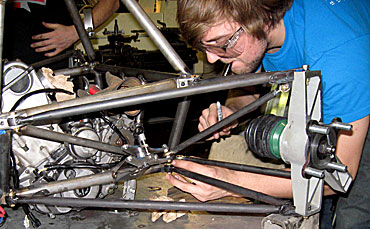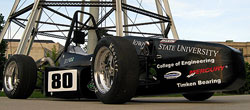Iowa State Formula SAE team looks for speed in re-engineered race car
05-13-08

Kyle Anderson, president of Iowa State's chapter of SAE, the Society of Automotive Engineers, works on this year's Formula SAE student-designed and student-built race car. Photo contributed by Iowa State's Formula SAE Team.
Contacts:
Kyle Anderson, Iowa State's SAE chapter, (847) 361-4899, kgander@iastate.edu
John Dunham, Iowa State Formula SAE team, (816) 244-4752, jfdunham@iastate.edu
Mike Krapfl, News Service, (515) 294-4917, mkrapfl@iastate.edu
Iowa State Formula SAE team looks for speed in re-engineered race car
AMES, Iowa -- The talk around the Formula SAE garage on the Iowa State University campus has been all about designing and building a mini open-wheel race car that's lighter, simpler, better handling and ultimately quicker through a race course.

The Iowa State Formula SAE Team's 2008 race car. Photo contributed by Iowa State's Formula SAE Team.
But quicker times for the $100,000, ethanol-powered race car might still be a year or so away.
It's a rebuilding year around the garage, said John Dunham, a junior studying mechanical engineering who's from St. Joseph, Mo., and is leading the race team's electrical crew.
Previous team members have graduated or moved on. Members of the new team -- which includes some first-year students -- have completely redesigned a race car that finished 18th in last year's annual competition, a best-ever seventh in 2006 and 18th in 2005.
"This is a prototype for us," said Kyle Anderson, a senior from Elgin, Ill. who's studying mechanical engineering and is the president of Iowa State's chapter of SAE, the Society of Automotive Engineers.
So Anderson said the team is taking the long view of the May 14-18 Formula SAE competition that's bringing 121 university teams to Michigan International Speedway in Brooklyn. He expects the Iowa State team will have some learning to do during the competition's four racing events: acceleration, cornering, autocross (a quick and curvy half-mile course that can be raced at average speeds of 25-30 mph) and endurance (a 13.7 mile race that features top speeds of 65 mph).
The team will also try to impress judges during a technical inspection, a cost and manufacturing analysis, a business presentation and an engineering design contest.
While the team still has plenty of work to do for this year's competition, Anderson thinks the team is on the right track.
Team members hoped for a lighter car and that's what they have. This year's car weighs about 390 pounds compared to last year's 450. A lot of that is due to a smaller engine and a shorter chassis.
Anderson also said the team has made a deliberate effort to manufacture parts and systems for the car that are simple rather than intricate.
The result should be a car that handles better and is easier to maintain.
That's a winning combination in Formula SAE. Teams often scramble to get their cars running and racing. And Anderson said better times are usually the result of better handling rather than higher horsepower.
But there was some apprehension in the garage earlier this week.
Juston Lisk, a senior from West Des Moines who's studying mechanical engineering and is leading the team's engine crew, was working to solve a problem with the team's Yamaha motorcycle engine. The team was trying to figure out how to get enough voltage to the engine so it would spark and fire under the high compression they're running in the motor's cylinder.
And that meant the student engineers had more problem-solving to do before loading up their race car.
-30-
